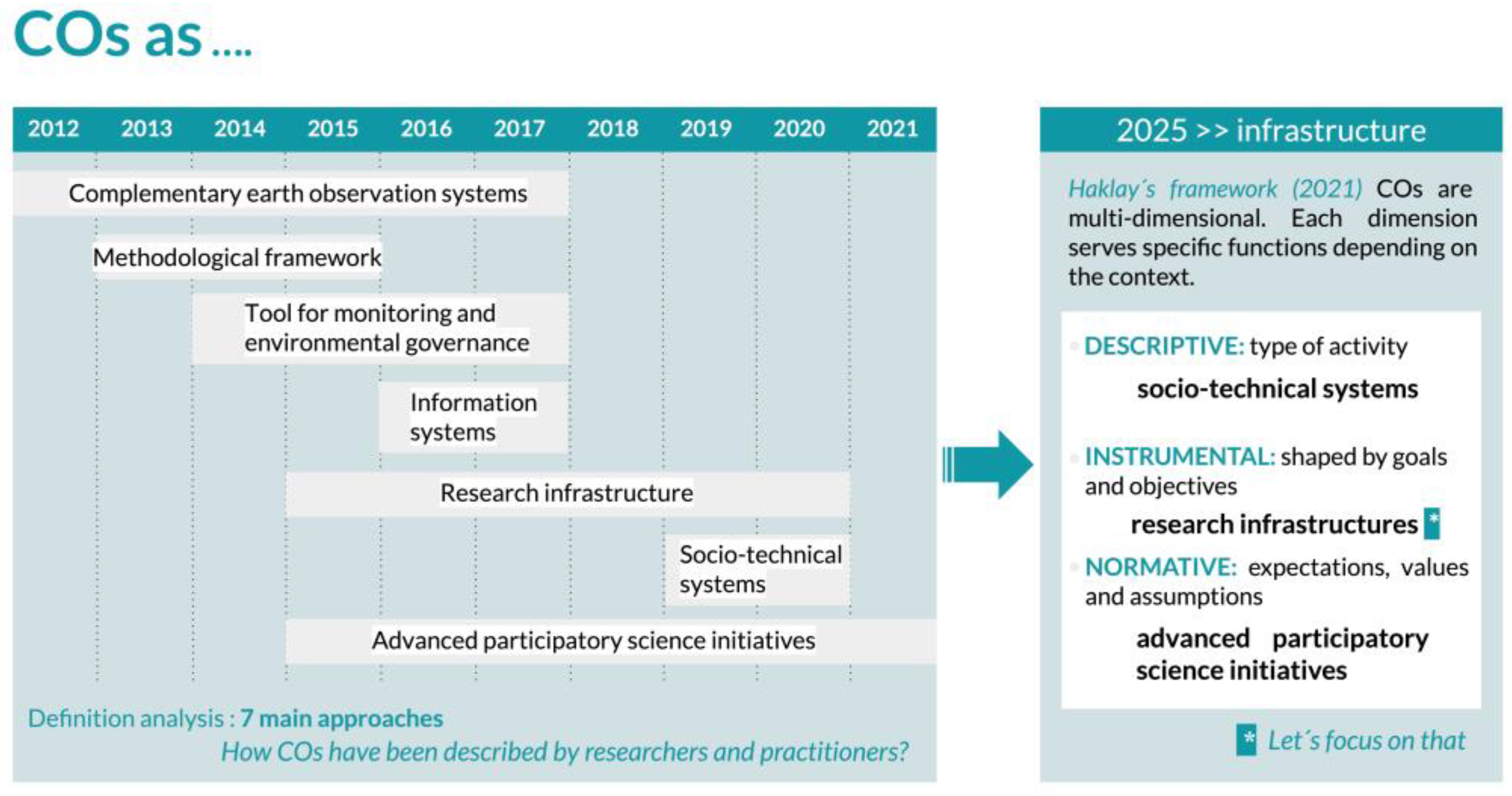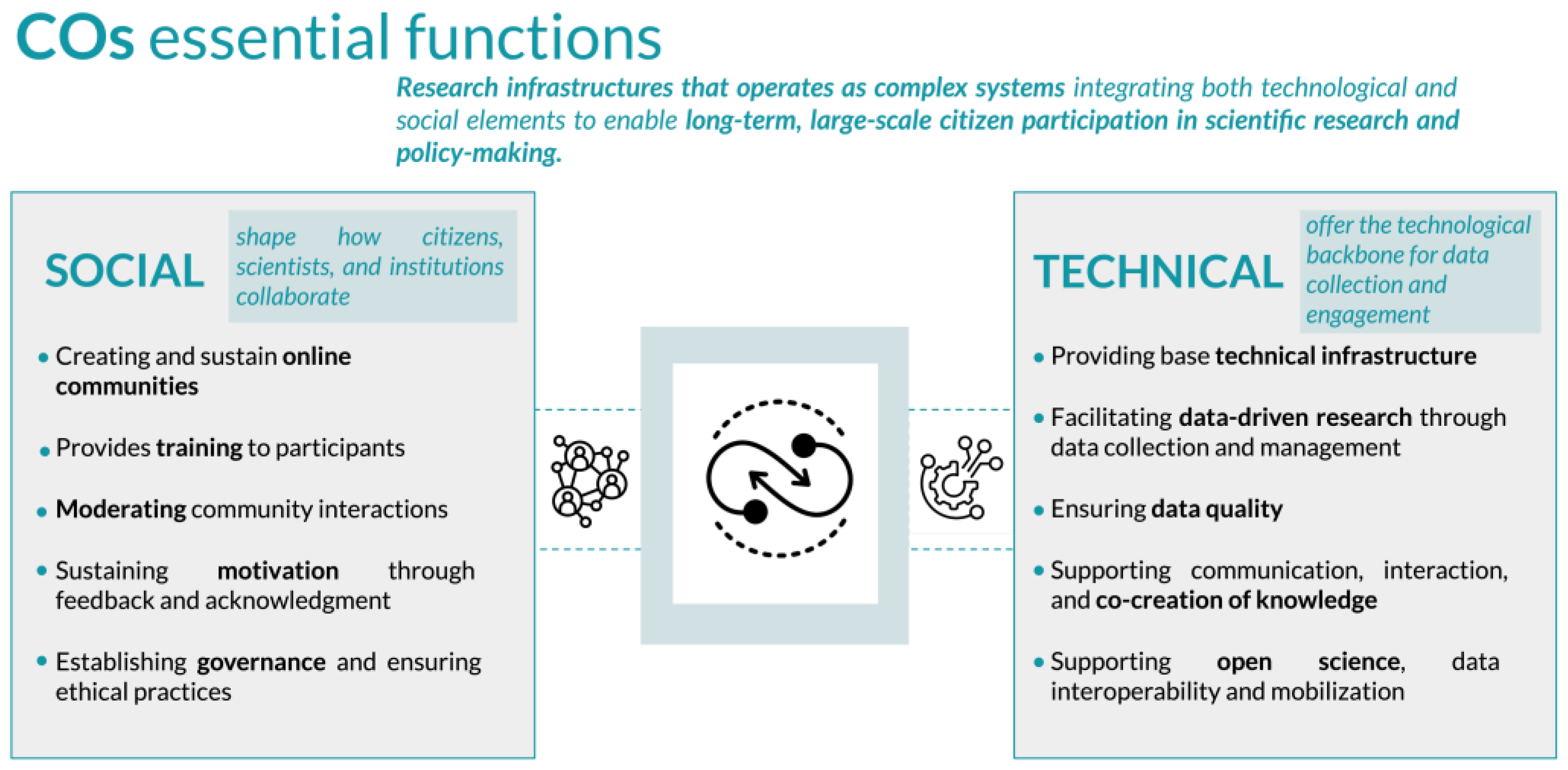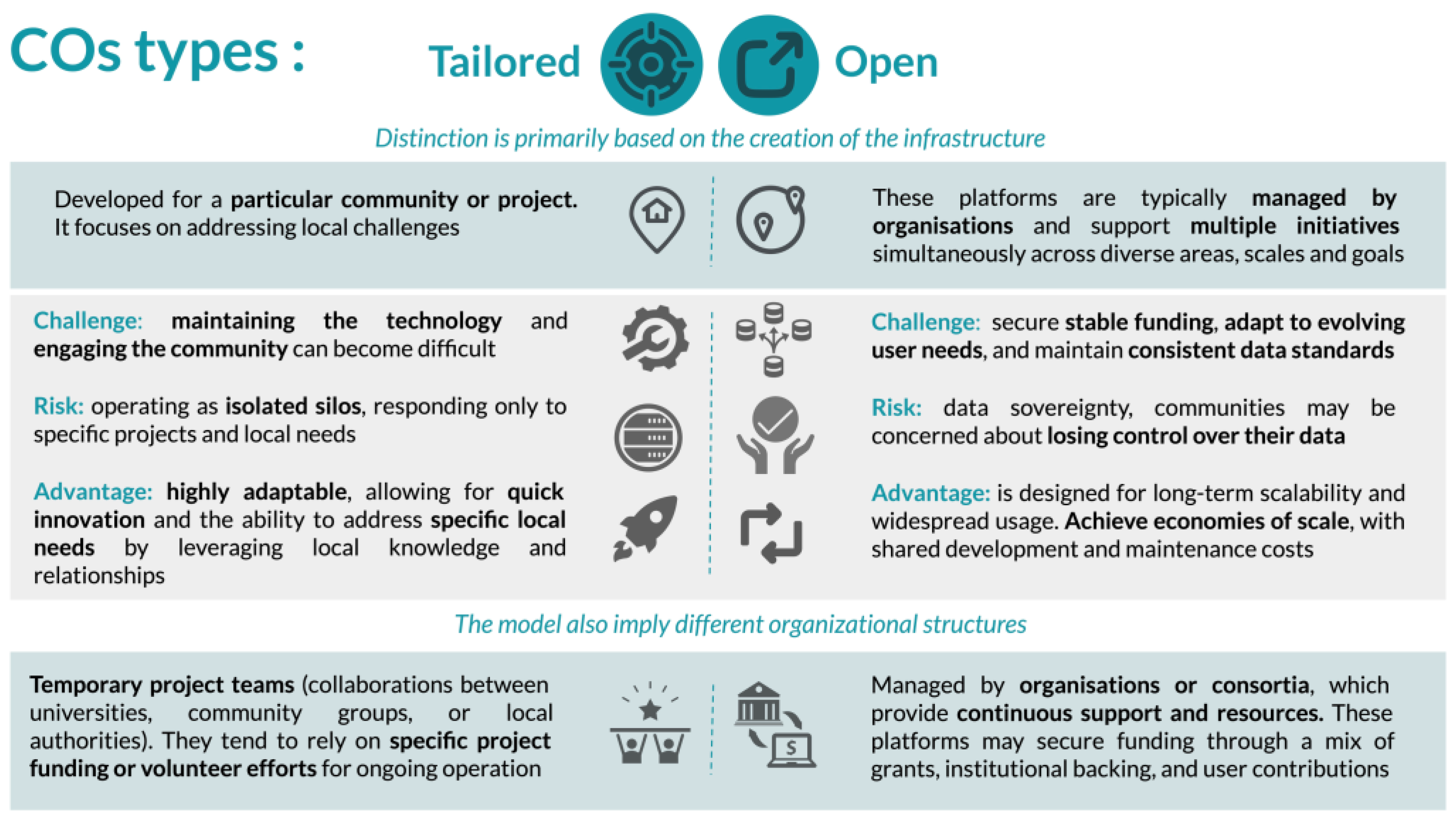The Backbone of Participatory Science: Reframing Citizen Observatories as Research Infrastructures
Abstract
1. Introduction
2. COs Concept: Origin and Roots
3. COs over Time: A Multifaceted Conceptual Trajectory
4. COs as Research Infrastructures: Essential Functions
5. Technical Functions
6. Social Functions
7. COs as Infrastructures: Essential Characteristics
8. CO Types: Tailored and Open COs
9. Conclusions
Author Contributions
Funding
Institutional Review Board Statement
Informed Consent Statement
Data Availability Statement
Acknowledgments
Conflicts of Interest
Abbreviations
| COs | Citizen observatories |
| CSPs | Citizen science platforms |
| CBM | Community-based monitoring |
| VGI | Volunteered geographic information |
| ICT | Information and communication technologies |
| EC | European Commission |
| EEA | European Environment Agency |
| NGOs | Non-Governmental Organizations |
| EMBIMOS | Environmental and Sustainability Participatory Information Systems |
| ICM-CSIC | Institut de Ciències del Mar - Consejo Superior de Investigaciones Científicas [Institute of Marine Sciences—Spanish Research Council] |
| UOC | Universitat Oberta de Catalunya (Open University of Catalonia) |
References
- Rathnayake, C.; Joshi, S.; Cerratto-Pargman, T. Mapping the current landscape of citizen-driven environmental monitoring: A systematic literature review. Sustain. Sci. Pract. Policy 2020, 16, 326–334. [Google Scholar] [CrossRef]
- Fraisl, D.; Campbell, J.; See, L.; Wehn, U.; Wardlaw, J.; Gold, M.; Moorthy, I.; Arias, R.; Piera, J.; Oliver, J.L.; et al. Mapping citizen science contributions to the UN sustainable development goals. Sustain. Sci. 2020, 15, 1735–1751. [Google Scholar] [CrossRef]
- Fraisl, D.; See, L.; Campbell, J.; Danielsen, F.; Andrianandrasana, H.T. The Contributions of Citizen Science to the United Nations Sustainable Development Goals and Other International Agreements and Frameworks. Citiz. Sci. Theory Pract. 2023, 8, 27. [Google Scholar] [CrossRef]
- Woods, S.M.; Daskolia, M.; Joly, A.; Bonnet, P.; Soacha, K.; Liñan, S.; Woods, T.; Piera, J.; Ceccaroni, L. How Networks of Citizen Observatories Can Increase the Quality and Quantity of Citizen-Science-Generated Data Used to Monitor SDG Indicators. Sustainability 2022, 14, 4078. [Google Scholar] [CrossRef]
- Ajates, R.; Hager, G.; Georgiadis, P.; Coulson, S.; Woods, M.; Hemment, D. Local action with global impact: The case of the grow observatory and the sustainable development goals. Sustainability 2020, 12, 10518. [Google Scholar] [CrossRef]
- Fritz, S.; See, L.; Carlson, T.; Haklay, M.; Oliver, J.L.; Fraisl, D.; Mondardini, R.; Brocklehurst, M.; Shanley, L.A.; Schade, S.; et al. Citizen science and the United Nations Sustainable Development Goals. Nat. Sustain. 2019, 2, 922–930. [Google Scholar] [CrossRef]
- Liu, H.Y.; Dörler, D.; Heigl, F.; Grossberndt, S. Citizen Science Platforms. In The Science of Citizen Science; Vohland, K., Land-Zandstra, A., Ceccaroni, L., Lemmens, R., Perelló, J., Ponti, M., Samson, R., Wagenknecht, K., Eds.; Springer International Publishing: Cham, Switzerland, 2021; pp. 439–459. [Google Scholar] [CrossRef]
- Cooper, C.; Hunter, D.L.; Archer, J.M.; Caballero-Gomez, H.; Hawn, C.; Johnson, V.; Lee_Jenni, G.; Osborne_Jelks, N.T.; Leggett, Z.; Pandya, R.; et al. A Positionality Tool to Support Ethical Research and Inclusion in the Participatory Sciences. Citiz. Sci. Theory Pract. 2024, 9. Available online: https://theoryandpractice.citizenscienceassociation.org/articles/10.5334/cstp.684 (accessed on 28 January 2025). [CrossRef]
- Haklay, M.; Dörler, D.; Heigl, F.; Manzoni, M.; Hecker, S.; Vohland, K. What Is Citizen Science? The Challenges of Definition. In The Science of Citizen Science; Vohland, K., Land-Zandstra, A., Ceccaroni, L., Lemmens, R., Perelló, J., Ponti, M., Samson, R., Wagenknecht, K., Eds.; Springer International Publishing: Cham, Switzerland, 2021; pp. 13–33. [Google Scholar] [CrossRef]
- Hunter, D.; Greg, N.; Balgopal, M. What’s in a name? The paradox of citizen science and community science. Front. Ecol. Environ. 2023, 21, 244–250. [Google Scholar] [CrossRef]
- Chandler, M.; See, L.; Copas, K.; Bonde, A.M.Z.; López, B.C.; Danielsen, F.; Legind, J.K.; Masinde, S.; Miller-Rushing, A.J.; Newman, G.; et al. Contribution of citizen science towards international biodiversity monitoring. Biol. Conserv. 2017, 213, 280–294. [Google Scholar] [CrossRef]
- Palacin-Silva, M.; Seffah, A.; Heikkinen, K.; Porras, J.; Pyhälahti, T.; Sucksdorff, Y.; Anttila, S.; Alasalmi, H.; Bruun, E.; Junttila, S. State-of-the Art Study in Citizen Observatories: Technological Trends, Development Challenges and Research Avenues; Finnish Environment Institute: Helsinki, Finland, 2016; Available online: https://helda.helsinki.fi/handle/10138/164810 (accessed on 4 November 2019).
- WeObserve Consortium. Citizen Observatories Landscape Web Map. 2020. Available online: https://www.weobserve.eu/knowledge-base/citizen-observatories/cos-landscape/citizen-observatories-landscape-web-map/ (accessed on 8 July 2024).
- EU-Citizen. Science Consortium. EU-Citizen.Science. Available online: https://eu-citizen.science/ (accessed on 25 March 2022).
- Civis—Plataforma de Ciência Cidadã. 2023. Available online: https://civis.ibict.br/ (accessed on 16 August 2023).
- Waller, J. Will Citizen Science Take Over? 2019. Available online: https://data-blog.gbif.org/post/gbif-citizen-science-data/ (accessed on 12 May 2025).
- CitSci.org. Available online: https://citsci.org/ (accessed on 14 February 2025).
- Anecdata.org. Available online: https://www.anecdata.org/welcome (accessed on 28 March 2025).
- Roger, E.; Kellie, D.; Slatyer, C.; Brenton, P.; Torresan, O.; Wallis, E.; Zerger, A. Open Access Research Infrastructures are Critical for Improving the Accessibility and Utility of Citizen Science: A Case Study of Australia’s National Biodiversity Infrastructure, the Atlas of Living Australia (ALA). Citizen Science: Theory and Practice. 25 September 2023, p. 8. Available online: https://theoryandpractice.citizenscienceassociation.org/articles/10.5334/cstp.564 (accessed on 20 December 2024).
- Team eBird. 2023 Year in Review: EBird, Merlin, Macaulay Library, and Birds of the World—eBird. Available online: https://ebird.org/ebird/news/2023-year-in-review (accessed on 28 March 2025).
- Observation.org. Observation.org. Available online: https://observation.org/stats/ (accessed on 14 February 2025).
- Site Stats·iNaturalist. iNaturalist. Available online: https://www.inaturalist.org/stats (accessed on 14 February 2025).
- Observations. iNaturalist. Available online: https://www.inaturalist.org/observations (accessed on 14 February 2025).
- Välkommen till Artportalen—Artportalen. Available online: https://www.artportalen.se/ (accessed on 8 April 2025).
- Stats—Pl@ntNet identify. Available online: https://identify.plantnet.org/stats (accessed on 28 March 2025).
- Our Story|Project Noah. Available online: https://projectnoah.org/our-story (accessed on 14 February 2025).
- MINKA Citizen Observatory. Observations. EMBIMOS research group, Institut de Ciències del Mar (ICM-CSIC). Available online: https://minka-sdg.org/observations (accessed on 14 February 2025).
- CyberTracker. CyberTracker. Available online: https://cybertracker.org/ (accessed on 12 May 2025).
- Digital X Solution: CyberTracker Classic. Available online: https://digitalx.undp.org/cybertracker-classic_1.html (accessed on 12 May 2025).
- India Biodiversity Portal. India Biodiversity Portal. Available online: https://indiabiodiversity.org/ (accessed on 12 May 2025).
- Liu, H.Y.; Grossberndt, S.; Kobernus, M. Citizen Science and Citizens’ Observatories: Trends, Roles, Challenges and Development Needs for Science and Environmental Governance; Ubiquity Press: London, UK, 2017. [Google Scholar]
- Wehn, U.; Almomani, A. Incentives and barriers for participation in community-based environmental monitoring and information systems: A critical analysis and integration of the literature. Environ. Sci. Policy 2019, 101, 341–357. [Google Scholar] [CrossRef]
- WeObserve consortium. Roadmap for the uptake of the Citizen Observatories’ knowledge base. Rep. Submitt. Eur. Comm. 2021. [Google Scholar] [CrossRef]
- Brenton, P.; von Gavel, S.; Vogel, E.; Lecoq, M.E. Technology infrastructure for citizen science. In Citizen Science; Hecker, S., Haklay, M., Bowser, A., Makuch, Z., Vogel, J., Bonn, A., Eds.; Innovation in Open Science, Society and Policy; UCL Press: London, UK, 2018; pp. 63–80. Available online: https://www.jstor.org/stable/j.ctv550cf2.12 (accessed on 9 March 2021).
- Momino, J.M.; Piera, J.; Jurado, E. Citizen observatories as advanced learning environments. In Analyzing the Role of Citizen Science in Modern Research; Advances in knowledge acquisition transfer and management (AKATM) book series; IGI Global: Hersey, PA, USA, 2017; pp. 192–212. [Google Scholar]
- Gold, Margaret. D2.1 EU Citizen Observatories Landscape Report—Frameworks for Mapping Existing CO Initiatives and Their Relevant Communities and Interactions. European Citizen Science Association ECSA—WeObserve. 2018. Available online: https://zenodo.org/record/3670895#.XpdqKplS_b0 (accessed on 4 November 2019).
- Montargil, F.; Santos, V. Communication with citizens in the first EU citizen observatories experiences. In Proceedings of the European Conference on e-Government, ECEG; Dias Rouco, J.C., Vieira Borges, J., Eds.; Volume Part F129463; Academic Conferences Limited: Reading, UK, 2017; pp. 96–103. Available online: https://repositorio.ipl.pt/bitstream/10400.21/7830/1/Montargil%20and%20Santos_ECDG%202017_Proceedings.pdf (accessed on 12 February 2025).
- Piera, J.; Justamante, Á. Citizen science through Cos4Cloud. EU Res. 2022, 33, 27–29. [Google Scholar]
- Etaligent.NET. EU BON—Citizens’ Observatories: Empowering European Society—Open Conference. EUBON. Available online: http://www.eubon.eu//news/11597_Citizens%E2%80%99%20Observatories:%20Empowering%20European%20Society%20-%20Open%20Conference (accessed on 1 April 2025).
- Grainger, A. Citizen Observatories and the New Earth Observation Science. Remote Sens. 2017, 9, 153. [Google Scholar] [CrossRef]
- Angulo Marcial, N. ¿Qué son los observatorios y cuáles son sus funciones? Innovación Educ. 2009, 9, 5–17. [Google Scholar]
- Silva, R. ¿Qué es un Observatorio Ciudadano? Apuntes para la discusión. Vinculos Sociol. Análisis Y opinión. 2013, 4, 189–202. [Google Scholar]
- Natal, A.; Díaz, O. Observatorios Ciudadanos: Nuevas Formas de Participación en la Sociedad; Universidad Autónoma Metropolitana: Mexico City, Mexico, 2014. [Google Scholar]
- Keseru, I.; Wuytens, N.; Macharis, C. Citizen observatory for mobility: A conceptual framework. Transp. Rev. 2019, 39, 485–510. [Google Scholar] [CrossRef]
- Simpson, R.; Page, K.R.; De Roure, D. Zooniverse: Observing the World’s Largest Citizen Science Platform. In Proceedings of the International Conference on World Wide Web (WWW Companion); Association for Computing Machinery, Inc.: New York, NY, USA, 2014; pp. 1049–1054. [Google Scholar]
- O’Grady, M.; Mangina, E. Adoption of Responsible Research and Innovation in Citizen Observatories. Sustainability 2022, 14, 7379. [Google Scholar] [CrossRef]
- Prem, E.; Sanz, F.S.; Lindorfer, M.; Lampert, D.; Irran, J. Open Digital Science; Final Study Report; eutema GmbH: Vienna, Austria, 2016. [Google Scholar]
- mukih. Citizens Observatories: Empowering European Society. Po Ve Sham—Muki Haklay’s Personal Blog. 2014. Available online: https://povesham.wordpress.com/2014/12/04/citizens-observatories-empowering-european-society/ (accessed on 1 April 2025).
- Liu, H.Y.; Kobernus, M.; Broday, D.; Bartonova, A. A conceptual approach to a citizens’ observatory—Supporting community-based environmental governance. Environ. Health 2014, 13, 107. [Google Scholar] [CrossRef]
- Hager, G.; Gold, M.; Wehn, U.; Ajates, R.; See, L.; Woods, M.; Tsiakos, C.; Masó, J.; Fraisl, D.; Moorthy, I.; et al. Onto new horizons: Insights from the WeObserve project to strengthen the awareness, acceptability and sustainability of Citizen Observatories in Europe. JCOM 2021, 20, A01. [Google Scholar] [CrossRef]
- European Commission. FP7 Cooperation Work Programme 2012: Environment (Including Climate Change). 2012. Available online: https://ec.europa.eu/research/participants/data/ref/fp7/89467/f-wp-201201_en.pdf (accessed on 17 February 2022).
- Ciravegna, F.; Huwald, H.; Lanfranchi, V.; Wehn de Montalvo, U. Citizen Observatories: The WeSenseIt Vision; Inspire Conference: Florence, Italy, 2013. [Google Scholar]
- Mazumdar, S.; Lanfranchi, V.; Ireson, N.; Wrigley, S.; Bagnasco, C.; Wehn, U.; McDonagh, R.; Ferri, M.; McCarthy, S.; Huwald, H. Citizens observatories for effective Earth observations: The WeSenseIt approach. Environ. Sci. 2016, 25, 56–61. [Google Scholar]
- Hunt, N.; O’Grady, M.; Muldoon, C.; Kroon, B.; Rowlands, T.; Wan, J.; O’Hare, G.M. Citizen Science: A Learning Paradigm for the Smart City? Interact. Des. Archit. 2015, 27, 44–65. [Google Scholar] [CrossRef]
- Wehn, U.; Evers, J. The social innovation potential of ICT-enabled citizen observatories to increase eParticipation in local flood risk management. Technol. Soc. 2015, 42, 187–198. [Google Scholar] [CrossRef]
- European Commission. Coordination of Citizens’ Observatories Initiatives. TOPIC ID: SC5-19-2017. 2016. Available online: https://ec.europa.eu/info/funding-tenders/opportunities/portal/screen/opportunities/topic-details/sc5-19-2017 (accessed on 17 February 2022).
- Ferri, M.; Wehn, U.; See, L.; Fritz, S. The Value of Citizen Science for Flood Risk Reduction: Cost-benefit Analysis of a Citizen Observatory in the Brenta-Bacchiglione Catchment. Hydrol. Earth Syst. Sci. Discuss. 2019, 1–27. [Google Scholar] [CrossRef]
- Hemment, D.; Woods, M.; Ajates, R.; Cobley, A.; Xaver, A. Enhancing collective intelligence through citizen science: The case of the GROW citizens’ observatory. In Collective Intelligence; 2019 Proceedings; Association for Computing Machinery (ACM): New York, NY, USA, 2019; pp. 1–4. Available online: https://discovery.dundee.ac.uk/en/publications/enhancing-collective-intelligence-through-citizen-science-the-cas-2 (accessed on 18 April 2020).
- Wehn, U.; Pfeiffer, E. Guidelines for Citizen Observatories and Future Recommendations. Groundtruth 2.0. 2020. Available online: https://gt20.eu/wp-content/uploads/2020/06/GT2.0-D1.13-Guidelines-for-Citizen-Observatories-FINAL.pdf (accessed on 4 March 2021).
- Gold, M.; Wehn, U. Mission Sustainable: Fostering an Enabling Environment for Sustainable Citizen Observatories. WeObserve policy brief 2. 2020. Available online: https://zenodo.org/record/4001672 (accessed on 8 September 2021).
- Heaton, L. Chains of Participation in Producing Biodiversity Infrastructures: Digital Reconfigurations of Scientific Work. Sci. Cult. 2022, 33, 297–320. [Google Scholar] [CrossRef]
- Spasiano, A. Citizen science and socio-technical perspective: Reflection on a possible integration. In CEUR Workshop Proc. CEUR-WS; Bednar, P., Bednar, P., Nolte, A., Nolte, A., Rajanen, M., Islind, A.S., Hult, H.V., Ravarini, A., Braccini, A.M., Eds.; CEUR-WS Team: Aachen, Germany, 2021; pp. 117–124. Available online: https://ceur-ws.org/Vol-3016/paper10.pdf (accessed on 15 January 2025).
- UNESCO. Bolstering Open Science Infrastructures for All—UNESCO Digital Library. 2022. Available online: https://unesdoc.unesco.org/ark:/48223/pf0000383711 (accessed on 26 April 2023).
- European Commission. European Research Infrastructures—European Commission. 2020. Available online: https://research-and-innovation.ec.europa.eu/strategy/strategy-research-and-innovation/our-digital-future/european-research-infrastructures_en (accessed on 21 December 2024).
- Albagli, S.; Py, H.; Iwama, A.Y. Data geovisualization and open and citizen science—The LindaGeo platform prototype. Digit. Humanit. Q. 2020, 14. Available online: https://digitalhumanities.org/dhq/vol/14/2/000452/000452.html (accessed on 23 January 2025).
- Skarlatidou, A.; Hamilton, A.; Vitos, M.; Haklay, M. What do volunteers want from citizen science technologies? A systematic literature review and best practice guidelines. JCOM 2019, 18, A02. Available online: https://jcom.sissa.it/archive/18/01/JCOM_1801_2019_A02 (accessed on 22 March 2020). [CrossRef]
- Corsín Jiménez, A. The Right to Infrastructure: A Prototype for Open Source Urbanism. Environ. Plan D 2014, 32, 342–362. [Google Scholar] [CrossRef]
- Fecher, B.; Kahn, R.; Sokolovska, N.; Völker, T.; Nebe, P. Making a Research Infrastructure: Conditions and Strategies to Transform a Service into an Infrastructure. Sci. Public Policy 2021, 48, 499–507. [Google Scholar] [CrossRef]
- Star, S.; Ruhleder, K. Steps Toward an Ecology of Infrastructure: Design and Access for Large Information Spaces. Inf. Syst. Res. 1996, 7, 111–134. [Google Scholar] [CrossRef]
- Maccani, G.; Goossensen, M.; Righi, V.; Creus, J.; Balestrini, M. Scaling up Citizen Science What Are the Factors Associated with Increased Reach and How to Lever Them to Achieve Impact; JRC Publications Repository: Ispra, Italy, 2020; Available online: https://publications.jrc.ec.europa.eu/repository/handle/JRC122219 (accessed on 6 February 2025).
- Programador de Medidores AireCiudadano—Aire Ciudadano. 2024. Available online: https://aireciudadano.com/programador-de-medidores-aireciudadano/ (accessed on 9 October 2024).
- ICTIO|AGUAS AMAZÓNICAS. 2021. Available online: https://aguasamazonicas.org/programas/ciencia-ciudadana/soluciones/ictio (accessed on 12 May 2025).
- Güntsch, A.; Overmann, J.; Ebert, B.; Bonn, A.; Le Bras, Y.; Engel, T.; Hovstad, K.A.; Lange Canhos, D.A.; Newman, P.; van Ommen Kloeke, E.; et al. National biodiversity data infrastructures: Ten essential functions for science, policy, and practice. BioScience 2025, 75, 139–151. [Google Scholar] [CrossRef]




| Citizen Observatory | Ref. | Host Institution and Country | Number of Projects Hosted | Number of Users-Accounts * | Number of Observations |
|---|---|---|---|---|---|
| Environmental and Biodiversity | |||||
| CitSci.Org | [17] | Colorado State University. USA. | >1400 | >17,000 | >165,000 observations >2.1 million measurements |
| Anecdata | [18] | MDI Biological Laboratory, Maine, USA. | >340 | >19,400 | >160,600 |
| BioCollect | [19] | Atlas of Living Australia (ALA). Australia. | 760 | - | >51 million |
| Biodiversity | |||||
| eBird | [20] | Cornell Lab, Cornell University. USA. | - | >930,000 | >1.6 billion |
| Observation.org | [21] | Observation International. The Netherlands. | - | >470,000 | >269 million |
| iNaturalist | [22,23] | iNaturalist org. USA. | >180,000 | >3.5 million | >226 million |
| ArtPortalen | [24] † | SLU, Swedish Environmental Protection Agency, Swedish University of Agricultural Science. Sweden. | >5000 | >90,000 | >110 million |
| Pl@ntNet | [25] | CIRAD, INRAE, INRIA and IRD. France. | - | >7.6 million * | >25 million |
| Project Noah | [26] | New York University. USA. | >1000 | >450,000 | >920,000 |
| MINKA | [27] | EMBIMOS research group. Institut of Ciències del Mar (ICM-CSIC). Spain. | >300 | >1.400 | >380,000 |
| Cybertracker | [28,29] | Cybertracker Conservation NPC (Non Profit Company). Cape Town, South Africa. | >1000 ** | >50,000 | - |
| India Biodiversity Portal (IBP) | [30] | IBP Consortium. India. | - | 25,800 | >1.61 million |
| Authors | Ref. | Definition Focused on the Main Role of COs | Year |
|---|---|---|---|
| European Commission | [51] |
| 2012 |
| Ciravegna et al. in Mazumdar et al. | [52,53] |
| 2013 |
| Liu et al. | [49] |
| 2014 |
| Hunt et al. | [54] |
| 2015 |
| Wehn et al. | [55] |
| 2015 |
| Palacin-Silva et al. | [12] |
| 2016 |
| European Commission | [56] |
| 2017 |
| Grainger | [40] |
| 2017 |
| Momino et al. | [35] |
| 2017 |
| Montargil and Santos | [37] |
| 2017 |
| Ferri et al. | [57] |
| 2019 |
| Hemment et al. | [58] |
| 2019 |
| Ajates et al. | [5] |
| 2020 |
| Groundtruth 2.0 | [59] |
| 2020 |
| Gold et al. | [60] |
| 2020 |
| Rathnayake et al. | [1] |
| 2020 |
| Hager et al. | [50] |
| 2021 |
| WeObserve Consortium | [33] |
| 2021 |
Disclaimer/Publisher’s Note: The statements, opinions and data contained in all publications are solely those of the individual author(s) and contributor(s) and not of MDPI and/or the editor(s). MDPI and/or the editor(s) disclaim responsibility for any injury to people or property resulting from any ideas, methods, instructions or products referred to in the content. |
© 2025 by the authors. Licensee MDPI, Basel, Switzerland. This article is an open access article distributed under the terms and conditions of the Creative Commons Attribution (CC BY) license (https://creativecommons.org/licenses/by/4.0/).
Share and Cite
Soacha-Godoy, K.; López-Borrull, A.; Serrano, F.; Piera, J. The Backbone of Participatory Science: Reframing Citizen Observatories as Research Infrastructures. Sustainability 2025, 17, 4608. https://doi.org/10.3390/su17104608
Soacha-Godoy K, López-Borrull A, Serrano F, Piera J. The Backbone of Participatory Science: Reframing Citizen Observatories as Research Infrastructures. Sustainability. 2025; 17(10):4608. https://doi.org/10.3390/su17104608
Chicago/Turabian StyleSoacha-Godoy, Karen, Alexandre López-Borrull, Fermín Serrano, and Jaume Piera. 2025. "The Backbone of Participatory Science: Reframing Citizen Observatories as Research Infrastructures" Sustainability 17, no. 10: 4608. https://doi.org/10.3390/su17104608
APA StyleSoacha-Godoy, K., López-Borrull, A., Serrano, F., & Piera, J. (2025). The Backbone of Participatory Science: Reframing Citizen Observatories as Research Infrastructures. Sustainability, 17(10), 4608. https://doi.org/10.3390/su17104608









